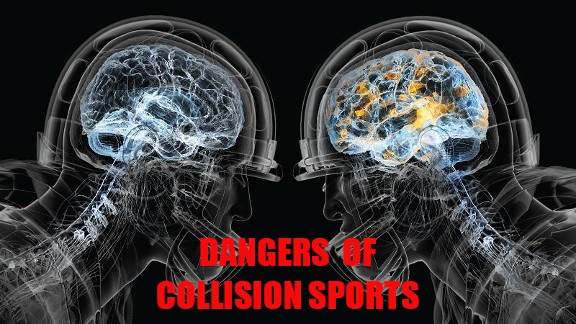The Dangers of Collision Sports

The dangers of collision sports are widely known, yet not much has been done to combat this issue. (Paraskevas Paraskevaidis \ for Lincoln Lion Tales)
“And, Hike ─” The shrill whistle screams across the field and the bodies start moving, heavily crashing into each other. Frantically, Zach looks for an opening, an opportunity to pass the ball and make a game changing play. And suddenly there it was, the moment he’d been waiting for. Zach prepares his strongest throw, just a few seconds, and the game would be won. He throws and ─Blam─ Zach goes down with a direct hit to the head. Zach Lystedt just sustained a traumatic brain injury. He was rushed to the hospital to undergo emergency surgery to relieve the swelling on the left and right side of his skull. These are the dangers that our children, as young as 10, and National Football Stars face every time they step on the field.
Playing a lifetime of football can lead to major brain problems that permanently affect or be the cause of death. Even though football isn’t just a contact sport it still affects players’ head when met at contact with another player. When collisions occur the probability of one or both player getting hit with blunt force in the upper region of the body is almost likely to happen all the time. As the brain is hit with massive force, the brain outrageously bobbles back and forth which damages the brain significantly. After the collision, whoever tackled who will be left with a concussion and due to how much force was put to the player it depends how painful that concussion will be.
When playing football, concussions will be present to either team and depending how severe the player was injured. According to news article Vox “… the latest NFL injury data released in January, there was a 13.5 percent increase in diagnosed concussion from 2016 to 2017 during the preseason and regular season.” This shows that concussions are more frequently happening and even at practices. When a player sustains multiple concussions, they develop CTE, which stands for chronic traumatic encephalopathy. CTE is caused by many concussions and can have a long lasting effect on the brain. Multiple injures dislodge a protein called tau which clumps together in the tissue of the brain, interrupting critical information flow.
There is a wide range of CTE symptoms that a player can get going from forgetfulness to violent behavior. When a player has CTE, the player is mostly unaware, because this disease takes up to eight to ten years to manifest. Once the disease is triggered, it can get preposterously worse. With CTE there are four stages. Stage one consists of headaches, short-term memory loss, and loss of attention which is nothing compared to stage four. Stage four symptoms include profound loss of attention and concentration, executive dysfunction, language difficulties, explosively, aggressive tendencies, paranoia, depression, gait ,and visuospatial difficulties.
Lucky for our players, there are some ways to detect CTE other than slicing open your brain. The US Food and Drug Administration has, for the first time, approved a blood test to help detect concussion in adults. This test can be taken within 12 hours of the injury for prosperous results. After 3-4 hours the test results come out and help the doctor whether the patient needs further care and treatment. “Over 90% of CT scans (for concussion) are negative. And you get 200 times the radiation of a chest X-ray. It’s expensive; it’s not terrific,” said Hank Nordhoff, chairman and CEO of Banyan Biomarkers.
But the NFL is not too worried. In an October 2013 item published at Deadspin, NFL Dr. Matt McCarthy explained that there’s still no clear link between football and CTE, and more importantly between CTE and various cognitive problems that occur as football players age. For some, the popular consensus has become that playing football at any level means that the person who has played football at any level already has CTE, and that CTE is a time bomb that eventually will trigger the implosion of normal brain function. However many argue that this is not the case and that this effect between CTE and football is over-exaggerated.
Sources;
| sport, Guardian. “Its not OK: NFL concussions rose 16% in 2017 amid CTE fears.” The Guardian, Guardian News and Media, 28 Feb. 2018, www.theguardian.com/sport/2018/feb/28/nfl-concussion-numbers-2017-season. |
| Kounang, Nadia. “FDA approves first blood test for concussion.” CNN, Cable News Network, 14 Feb. 2018, www.cnn.com/2018/02/14/health/concussion-blood-test-fda-bn/index.html. |
| Lardieri, Alexa. “FDA OKs Blood Test to Detect Concussions.” US News, 15 Feb. 2018, www.usnews.com/news/health-care-news/articles/2018-02-15/fda-oks-blood-test-to-detect-concussions. |
| Lardieri, Alexa. “FDA OKs Blood Test to Detect Concussions.” US News, 15 Feb. 2018, www.usnews.com/news/health-care-news/articles/2018-02-15/fda-oks-blood-test-to-detect-concussions. |
| Kounang, Nadia. “FDA approves first blood test for concussion.” CNN, Cable News Network, 14 Feb. 2018, www.cnn.com/2018/02/14/health/concussion-blood-test-fda-bn/index.html. |
| Ho, Shannon. “CTE Reports, Concussions Deter Parents From Youth Football.” NBC Southern California, NBC Southern California, 31 July 2017, www.nbclosangeles.com/news/health/CTE-Reports-Impact-Future-of-Youth-Football-436639243.html. |
| Gaillot, Ann-Derrick. “There is now no question that playing football is bad for your brain.” The Outline, The Outline, 25 July 2017, theoutline.com/post/1968/football-is-bad-for-your-brain?zd=1&zi=pkoiwovn. |
| Huston, Warner T. “Maryland Democrats Propose Banning Youth Football, Contact Sports from Public Property.” Breitbart, 8 Feb. 2018, doi:10.1021/om010545h. |
| Florio, Posted by Mike. “NFL doctor says CTE is being “over-Exaggerated”.” ProFootballTalk, 19 Mar. 2015, profootballtalk.nbcsports.com/2015/03/18/nfl-doctor-says-cte-is-being-over-exaggerated/. |










